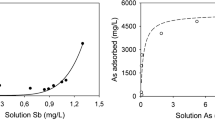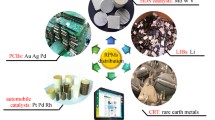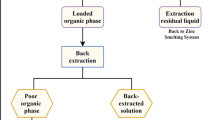Abstract
As the demand for metal minerals grows, the number of mine tailings increases dramatically worldwide. Toxic heavy metals (HMs) in tailings tend to migrate into the environment and cause serious damage to the surroundings. Possible eco-friendly solutions for the in situ stabilization of HMs in tailing ponds are required to reduce their mobility. Leaching tests were performed with attapulgite, zeolite, and bentonite to determine which stabilizer is more efficient. As a result, attapulgite has more significant effect with certain dose on metal mine tailings than zeolite or bentonite, especially in a strongly acidic environment. In addition, an in situ stabilization experiment was performed by adding a stabilizer to a lead-zinc mine tailing pond with high-pressure rotary jet technology. The field experiment indicated that the concentrations of HMs in the leachate substantially decreased (30.5% for Cr, 43.1% for Cu, 87.8% for Zn, 82.9% for Cd, and 42.4% for Pb) after the HMs were stabilized by high-pressure rotary jet technology. A set of parameters for the rotary jet process was obtained when the in situ stabilization experiment was carried out.










Similar content being viewed by others
References
Ali A, Guo D, Zhang Y, Sun X, Jiang S, Guo Z, Huang H, Liang W, Li R, Zhang Z (2017) Using bamboo biochar with compost for the stabilization and phytotoxicity reduction of heavy metals in mine-contaminated soils of China. Sci Rep 7:2690
Álvarez-Ayuso E, García-Sánchez A (2003) Palygorskite as a feasible amendment to stabilize heavy metal polluted soils. Environ Pollut 125:337–344
Andrade S, Moffett J, Correa JA (2006) Distribution of dissolved species and suspended particulate copper in an intertidal ecosystem affected by copper mine tailings in Northern Chile. Mar Chem 101:203–212
Cappuyns V, Swennen R (2008) The use of leaching tests to study the potential mobilization of heavy metals from soils and sediments: a comparison. Water Air Soil Pollut 191:95–111
Cui M, Lee Y, Choi J, Kim J, Han Z, Son Y, Khim J (2018) Evaluation of stabilizing materials for immobilization of toxic heavy metals in contaminated agricultural soils in China. J Clean Prod 193:748–758
Falayi T, Ntuli F (2014) Removal of heavy metals and neutralisation of acid mine drainage with un-activated attapulgite. J Ind Eng Chem 20:1285–1292
Fan L, Zhao F, Liu J, Hudson-Edwards KA (2018) Dissolution of realgar by Acidithiobacillus ferrooxidans in the presence and absence of zerovalent iron: implications for remediation of iron-deficient realgar tailings. Chemosphere 209:381–391
Gan F, Zhou J, Wang H, Du C, Chen X (2009) Removal of phosphate from aqueous solution by thermally treated natural palygorskite. Water Res 43:2907–2915
Gao J (2016) Study on application of geotechnical construction technology in contaminated site management. Explor Eng 43:75–79
Gonzalez MR, Pereyra AM, Zerbino R, Basaldella EI (2015) Removal and cementitious immobilization of heavy metals: chromium capture by zeolite-hybridized materials obtained from spent fluid cracking catalysts. J Clean Prod 91:187–190
Gu HH, Qiu H, Tian T, Zhan SS, Deng TH, Chaney RL, Wang SZ, Tang YT, Morel JL, Qiu RL (2011) Mitigation effects of silicon rich amendments on heavy metal accumulation in rice (Oryza sativa L.) planted on multi-metal contaminated acidic soil. Chemosphere 83:1234–1240
Gu JF, Zhou H, Tang HL, Yang WT, Zeng M, Liu ZM, Peng PQ, Liao BH (2019) Cadmium and arsenic accumulation during the rice growth period under in situ remediation. Ecotoxicol Environ Saf 171:451–459
Hu XF, Jiang Y, Shu Y, Hu X, Liu L, Luo F (2014) Effects of mining wastewater discharges on heavy metal pollution and soil enzyme activity of the paddy fields. J Geochem Explor 147:139–150
Jahanshahi R, Zare M, Schneider M (2014) A metal sorption/desorption study to assess the potential efficiency of a tailings dam at the Golgohar Iron Ore Mine, Iran. Mine Water Environ 33:228–240
Jeleni MN, Gumbo JR, Muzerengi C, Dacosta FA (2012) An assessment of toxic metals in soda mine tailings and a native grass: a case study of an abandoned Nyala Magnesite mine, Limpopo, South Africa. Water Pollut 1:415–426
Ko M-S, Kim J-Y, Park H-S, Kim K-W (2015) Field assessment of arsenic immobilization in soil amended with iron rich acid mine drainage sludge. J Clean Prod 108:1073–1080
Kumpiene J, Lagerkvist A, Maurice C (2008) Stabilization of As, Cr, Cu, Pb and Zn in soil using amendments--a review. Waste Manag 28:215–225
Li J, Chen Z, Shen J, Wang B, Fan L (2015a) The enhancement effect of pre-reduction using zero-valent iron on the solidification of chromite ore processing residue by blast furnace slag and calcium hydroxide. Chemosphere 134:159–165
Li Y, Shen F, Guo H, Wang Z, Yang G, Wang L, Zhang Y, Zeng Y, Deng S (2015b) Phytotoxicity assessment on corn stover biochar, derived from fast pyrolysis, based on seed germination, early growth, and potential plant cell damage. Environ Sci Pollut Res Int 22:9534–9543
Li X, Zhang X, Wang X, Cui Z (2019) Phytoremediation of multi-metal contaminated mine tailings with Solanum nigrum L. and biochar/attapulgite amendments. Ecotoxicol Environ Saf 180:517–525
Liang X, Han J, Xu Y, Sun Y, Wang L, Tan X (2014) In situ field-scale remediation of Cd polluted paddy soil using sepiolite and palygorskite. Geoderma 235-236:9–18
Mulligan CN, Yong RN, Gibbs BF (2001) Remediation technologies for metal-contaminated soils and groundwater: an evaluation. Eng Geol:193–207
Neaman A, Singer A (2011) Chapter 14 - The effects of palygorskite on chemical and physico-chemical properties of soils. In: Galàn E, Singer A (eds) Developments in clay science. Elsevier, pp 325–349
Qiao JT, Liu TX, Wang XQ, Li FB, Lv YH, Cui JH, Zeng XD, Yuan YZ, Liu CP (2018a) Simultaneous alleviation of cadmium and arsenic accumulation in rice by applying zero-valent iron and biochar to contaminated paddy soils. Chemosphere 195:260–271
Qiao P, Lei M, Yang S, Yang J, Zhou X, Dong N, Guo G (2018b) Development of a model to simulate soil heavy metals lateral migration quantity based on SWAT in Huanjiang watershed. China, JEnvS
Shim J, Shea PJ, Oh B-T (2014): Stabilization of heavy metals in mining site soil with silica extracted from corn cob. Water, Air, Soil Pollut. 225
Song G, Pai W, Jiang J, He B (2017) Research on rotary jet grouting technology applied in situ remediation of contaminated site. Explor Eng 44:85–89
Su X, Kushima A, Halliday C, Zhou J, Li J, Hatton TA (2018) Electrochemically-mediated selective capture of heavy metal chromium and arsenic oxyanions from water. Nat Commun:9
Sun X, Ning P, Tang X, Yi H, Li K (2012) Heavy metals migration in soil in tailing dam region of Shuikoushan, Hunan Province, China. Procedia Environ Sci 16:758–763
Wang Y, Shi J, Wang H, Lin Q, Chen X, Chen Y (2007) The influence of soil heavy metals pollution on soil microbial biomass, enzyme activity, and community composition near a copper smelter. Ecotoxicol Environ Saf 67:75–81
Wang B, Sun Z, Sun Q, Wang J, Du Z, Li C, Li X (2019a) The preparation of bifunctional electrospun air filtration membranes by introducing attapulgite for the efficient capturing of ultrafine PMs and hazardous heavy metal ions. Environ Pollut 249:851–859
Wang X, Yu HY, Li F, Liu T, Wu W, Liu C, Liu C, Zhang X (2019b) Enhanced immobilization of arsenic and cadmium in a paddy soil by combined applications of woody peat and Fe (NO3)3: possible mechanisms and environmental implications. Sci Total Environ 649:535–543
Wang Z, Tan K, Cai J, Hou S, Wang Y, Jiang P, Liang M (2019c) Silica oxide encapsulated natural zeolite for high efficiency removal of low concentration heavy metals in water. Colloids Surf Physicochem Eng Aspects 561:388–394
Xia WY, Du YJ, Li FS, Li CP, Yan XL, Arulrajah A, Wang F, Song DJ (2019) In-situ solidification/stabilization of heavy metals contaminated site soil using a dry jet mixing method and new hydroxyapatite based binder. J Hazard Mater 369:353–361
Xu Y, Liang X, Xu Y, Qin X, Huang Q, Wang L, Sun Y (2017) Remediation of heavy metal-polluted agricultural soils using clay minerals: a review. Pedosphere 27:193–204
Xu C, Qi J, Yang W, Chen Y, Yang C, He Y, Wang J, Lin A (2019a) Immobilization of heavy metals in vegetable-growing soils using nano zero-valent iron modified attapulgite clay. Sci Total Environ 686:476–483
Xu J, Liu C, Hsu P-C, Zhao J, Wu T, Tang J, Liu K, Cui Y (2019b) Remediation of heavy metal contaminated soil by asymmetrical alternating current electrochemistry. Nat Commun:10
Yang Y, Zhang H, Yuan H, Duan G, Jin D, Zhao F, Zhu Y (2018) Microbe mediated arsenic release from iron minerals and arsenic methylation in rhizosphere controls arsenic fate in soil-rice system after straw incorporation. Environ Pollut 236:598–608
Yao A, Ju L, Ling X, Liu C, Wei X, Qiu H, Tang Y, Morel JL, Qiu R, Li C, Wang S (2019) Simultaneous attenuation of phytoaccumulation of Cd and As in soil treated with inorganic and organic amendments. Environ Pollut 250:464–474
Yi H, Yan W, Liang X, Ouyang S, Ouyang Z, Guo J, He D (2014) Variation of inorganic anions in precipitation in Cinnamomum cam forests. Acta Ecol Sin 34:6528–6537
Yin H, Kong M, Gu X, Chen H (2017) Removal of arsenic from water by porous charred granulated attapulgite-supported hydrated iron oxide in bath and column modes. J Clean Prod 166:88–97
Yu H-Y, Liu C, Zhu J, Li F, Deng D-M, Wang Q, Liu C (2016) Cadmium availability in rice paddy fields from a mining area: the effects of soil properties highlighting iron fractions and pH value. Environ Pollut 209:38–45
Zhang X, Yang H, Cui Z (2018) Evaluation and analysis of soil migration and distribution characteristics of heavy metals in iron tailings. J Clean Prod 172:475–480
Zhang W, Qian L, Ouyang D, Chen Y, Han L, Chen M (2019) Effective removal of Cr (VI) by attapulgite-supported nanoscale zero-valent iron from aqueous solution: enhanced adsorption and crystallization. Chemosphere 221:683–692
Zhao YS, Zhou B (2013) High pressure rotary jet grouting pile with undrained caisson combined construction technology on nearby Yangtze River levee protection. Appl Mech Mater 718-720:1938–1944
Funding
This research is financially supported by the Project of China Geological Survey (12120123500016002107) and Open Fund Project of Key Laboratory of Eco-geochemistry of Ministry of Natural Resources of China (ZSDHJJ201803).
Author information
Authors and Affiliations
Corresponding author
Additional information
Responsible editor: Ioannis A. Katsoyiannis
Publisher’s note
Springer Nature remains neutral with regard to jurisdictional claims in published maps and institutional affiliations.
Rights and permissions
About this article
Cite this article
Ma, B., Wang, Z., Yuan, X. et al. In situ stabilization of heavy metals in a tailing pond with a new method for the addition of mineral stabilizers—high-pressure rotary jet technology. Environ Sci Pollut Res 27, 15388–15400 (2020). https://doi.org/10.1007/s11356-020-07782-9
Received:
Accepted:
Published:
Issue Date:
DOI: https://doi.org/10.1007/s11356-020-07782-9




